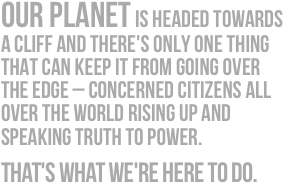by Nathan Thanki
With the dirty details of week one out of the way, COP17 is changing gears into the high-level segment. Heads of State are coming to town, security is ramped up (execpt at our hostel) and the drone of talks about an outcome becomes louder and more persistent. A lot off that buzz is around a Durban deal, the so called “Durban Mandate.” Most of the noise is around whether or not the BASIC countries – Brazil, South Africa, India, and China – will sign up to a deal that legally obliges them (and perhaps many other developing countries other than LDCs) to reduce their emissions. The questions that journalists and some major NGOs are fumbling around with are “will China sign in order to secure further commitments from annex-1 Parties?” and “what will it take for them to do that?”
China, as the world’s largest overall emitter, is sensing that the onslaught is about to start. With the wounds of the global backlash from Copenhagen (where China took a media crucifixion for not signing up to a ‘suicide pact’ ) still fresh, Chinese authorities decided that this weekend was the perfect time to set the record straight on what their official position is. I was lucky enough to gain access to the China pavilion Sunday morning to hear the Chinese negotiator Xie Zhenhua field some questions.
The general buzz yielded the expected questions such as: what are China’s expectations in general, on the Kyoto Protocol, does China support a legal outcome from the Bali Action Plan (BAP), and what are the conditions for China signing up to the mandate?
Xie sat by himself, unaided by staff or papers, and answered in depth on each point. Regarding expectations, China is quite clear that as the first commitment period of Kyoto (KP-1) comes to a well publicised end here, we must move on to the second (KP-2). As Africa group have pointed out as well in their press brief today, the fact that annex-1 Parties ratified the KP implies they will sign on to KP-2. A KP-2 must be an outcome: it’s the only legal treaty, and it uses the principles of common but differentiated responsibilities, and equity. Everyone keeps saying we cannot bury KP at Durban, and they’re right. We’d have to bury the entire regime too. The transition between the two commitment periods has to be seamless: there can’t be a gap where developed countries can pollute all they want.
The idea of China signing up to emissions reductions (in an obligatory way–they already have ambitious reductions in their 5 year plan) is contingent on the results of KP. China is also calling for a simultaneous review of the implementation of KP-1. How well did the developed countries do in meeting their promises (it’s not a trick question – the answer is the obvious: terribly!) and what does that then imply for KP-2, and long term cooperative action? As China see it, the issue of KP-2 is an issue of testing political trust. How can they trust the developed countries to actually reduce emissions in a non-legal treaty, given that they failed to do it even in a legal one. More to the point maybe, how can they trust that the USA (who notoriously pulled out of KP) will ratify the new mandate?
A deal is expected, yes, but not a perfect one. Rather, China expects a deal that can be signed and can be implemented.
Annex-1 countries like to point out that developing countries now account for over half the world’s emissions, and that they therefore must be included in new legal arrangements to reduce emissions. But under the Convention, developing counties have commitments – 1bii. And so far, it is developing countries who are showing they have committed to comparable reductions. Annex-1 countries have not shown the same honour.
However, even given that, China recognises that it must curb emissions. So the willingness is there – it’s a matter of the details (which is more than can be said of the US). China have indicated that the new legal outcome should be from the LCA, as mandated by BAP. They also have some conditions. One, the aforementioned review of KP-1. Two, a KP-2 that is separate and not contingent on a new mandate (as opposed to EU’s proposal). Three, progress in institutionalizing mechanisms under the areas of finance, tech transfer, adaptation, and capacity building. These ‘conditions’ are not new or unfounded, but based on 20 years negotiating.
The USA is trying to maintain its hegemonic power, so it must do all it can to trip up and smother it’s rivals. Stuck in a competitive rather than cooperative worldview, the States are playing a risky game with our planet’s atmosphere for the sake of trade flows and bragging rights. However, the recent developments in regard to China’s willingness to play ball could make things difficult for it’s neighbour and BASIC (sort-of) ally: India. With a similarly sized population–and large overall emissions–India looks set to come under fire from the media and governments of the developed world. One can already imagine the India bashing headlines of the tabloids. Are they ready?



Awesome write-up, thanks Nathan! Very interesting developments from China this COP…